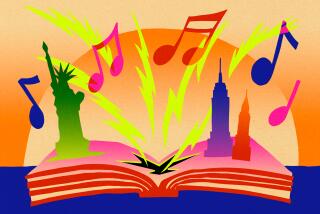Jazz Dictionary for the Everyman Debuts
- Share via
Weighing in at almost 10 pounds, “The New Grove Dictionary of Jazz” is the undisputed, world heavyweight champion of jazz scholarship, a highly readable, scrupulously researched two-volume, 1,400-page compendium packed with everything you always wanted to know about jazz but were afraid to ask.
About as hefty is the price: $295.
“We haven’t aimed the dictionary just at the jazz insider. And we don’t presume that everybody knows what a ‘honk’ (a loud blaring note on the saxophone) is or what a gig (job) is, or even what a clarinet is. We’ve aimed at a very general audience interested in the music,” chief editor and musicologist Barry Kernfeld said recently in a telephone interview from Oxford, England.
Kernfeld initiated the mammoth project and has devoted the last 4 1/2 years to editing and organizing the work, which has been written by more than 250 contributors from around the world.
“It has been a labor of love and absolutely all I’ve done for 4 1/2 years. I’m a saxophonist, but I haven’t played a note all that time,” said Kernfeld, who has been on the road promoting the magnum opus. The jazz scholar has been plugging the classy product in New York, San Francisco, Paris, London and even in a 5-minute appearance on NBC’s “Today Show.”
“We wanted to open up the literature for everyone. And we wanted it to be wide-ranging, with a lot more than just biographical entries,” Kernfeld said.
“We especially wanted it to be even-handed in its treatment of all styles because so many people get bogged down in factionalism in jazz. Some people hate bop, and some hate everything but bop, and we’ve tried to avoid that kind of divisiveness.”
The Grove music dictionaries are to music what the Oxford English Dictionary is to language--a scholarly source revered by many as the ultimate authority on matters of fact.
Lavishly illustrated with 220 rare photographs from the celebrated Frank Driggs Collection, the handsomely bound volumes--a bibliophile’s delight--surpass all earlier jazz dictionaries and encyclopedias in breadth and depth with its 4,500 entries, 3,000 biographies, 1,800 discographies and more than 1,000 cross-references.
Besides its exhaustive Who’s Who of jazz from Louis Armstrong to Joe Zawinul, the dictionary offers well-written entries on a dazzling variety of topics.
Among these are musical styles ranging from ragtime to free jazz, jazz instruments from kazoo to synthesizer, record labels both flourishing and defunct, fabled jazz nightclubs around the world and festivals.
There are more than 100 magazine-length entries on specialized areas, including improvisation (the heart of the matter for jazz), arrangement, harmony, form and notation. All are illustrated with copious musical illustrations.
“A small part of the dictionary is esoteric, but we also wanted to reach the serious fan who might want more in-depth knowledge of specialized subjects like harmony, or about specific things like how chordal substitution works in the bop style,” Kernfeld said.
If these more technical areas sound too dry, rest assured that there are plenty of juicy areas to tromp around in, including a fascinating 11-page essay on the role jazz has played in films.
Besides being an invaluable resource book, the dictionary is fun to thumb through.
Ardent fans will have a good time second-guessing the scholars and finding fault with their judgment about who gets in and who is excluded from this work, which is now the official jazz pantheon.
“You have to take a critical stand here, but that’s what Grove is all about,” Kernfeld said when asked about the dictionary’s process of natural selection.
“A quarter of the book is devoted to non-American subjects, so I’ve had New Yorkers asking me why there are so many Europeans. The English are asking why aren’t there more English, and the French are asking why there aren’t more French.”
Errors, of course, are the ultimate nightmare for editors of any dictionary or encyclopedia, and jazz, as liberated as it is, provides no exception.
Perhaps the most consistently misspelled name in jazz history has been Thelonious Monk’s unusual first name.
Grove has it right.
More to Read
The biggest entertainment stories
Get our big stories about Hollywood, film, television, music, arts, culture and more right in your inbox as soon as they publish.
You may occasionally receive promotional content from the Los Angeles Times.








